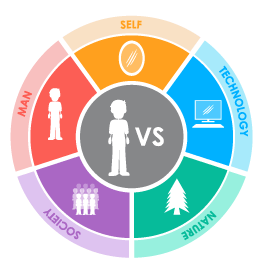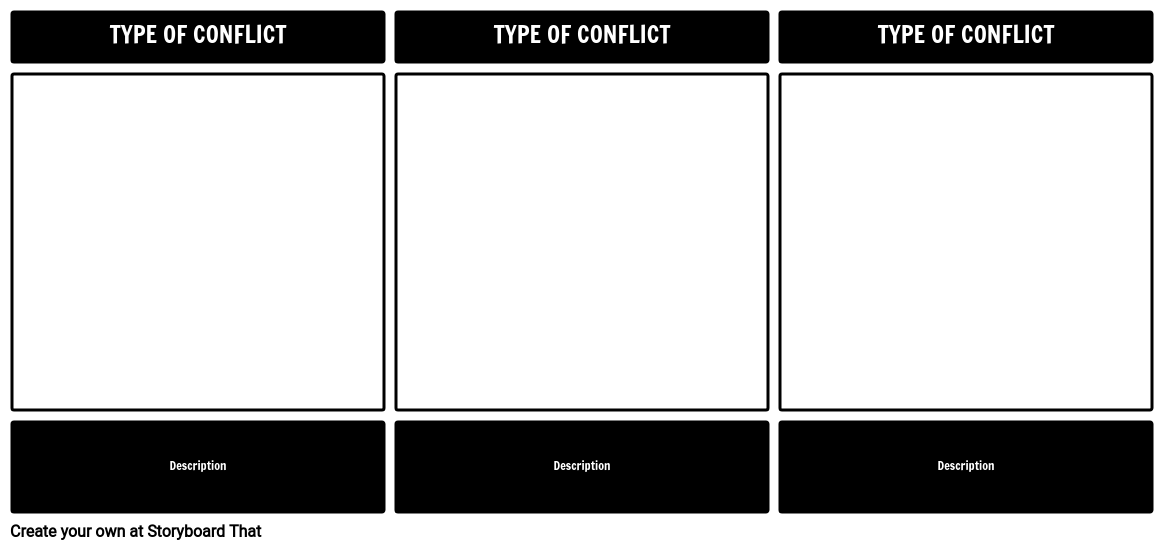Lesson Plan Overview
Literary conflicts are often taught during ELA units. Building on prior knowledge to achieve mastery level with our students is important. An excellent way to focus on the various types of literary conflict is through storyboarding. Having students choose an example of each literary conflict and depict it using the storyboard creator is a great way to reinforce your lesson!
In this story, the major conflicts arise from General Zaroff's practice of hunting human beings.
Examples of Literary Conflict from “The Most Dangerous Game”
MAN vs. MAN: Rainsford vs. Zaroff
Most of the conflict centers around Zaroff's bet with Rainsford. If Rainsford can survive on his island for three days while being hunted, Zaroff with help him leave Ship Trap Island.
MAN vs. NATURE: Rainsford vs. Nature
Rainsford must overcome and survive nature several times. Examples: he falls off the boat and must make it ashore, and he must survive in the jungle for three days.
MAN vs. SELF: Rainsford vs. Himself
At the beginning of the story, Rainsford expresses an intense admiration for hunting. However, once he becomes the prey, he sees the sport from a different angle, and begins to shift his views.
MAN vs. SOCIETY: Zaroff vs. Society
Zaroff's view of life and hunting have forced him into seclusion on Ship Trap Island. After becoming bored with hunting animals, he began to hunt humans, "the most dangerous game", which is illegal and frowned upon by society.
Template and Class Instructions
(These instructions are completely customizable. After clicking "Copy Activity", update the instructions on the Edit Tab of the assignment.)
Student Instructions
Create a storyboard that shows at least three forms of literary conflict in “The Most Dangerous Game”.
- Identify conflicts in “The Most Dangerous Game”.
- Categorize each conflict as Character vs. Character, Character vs. Self, Character vs. Society, Character vs. Nature, or Character vs. Technology.
- Illustrate conflicts in the cells, using characters from the story.
- Write a short description of the conflict below the cell.
Lesson Plan Reference
Student Rubric
(You can also create your own on Quick Rubric.)
| Proficient | Emerging | Beginning | Try Again | |
|---|---|---|---|---|
| Conflict Identification | Student identifies correct major conflicts and uses strong, clear textual evidence to support choice. | Student identifies correct major conflict and uses few or unclear details to support their choice. | Student identifies incorrect major conflict, and uses some details from the text to support their choice. | Student does not attempt to identify major conflict or identifies incorrect major conflict with no explanation. |
| Understanding Outcome | Student clearly shows the outcome of the conflict and its effects on the protagonist with evidence from the text. | Student shows the outcome of the conflict and its effect on the protagonist, but some evidence is unclear. | Student shows the outcome of the conflict, but does not examine its effect on the protagonist and uses some vague textual evidence. | Student does not clearly show the outcome of the conflict or use textual evidence. |
| Character | Storyboard includes all required characters and clearly names them. Goes above and beyond by adding additional details. | Storyboard includes all required characters and clearly names them. | Storyboard includes protagonist and antagonist but leaves out other required characters. | Storyboard does not include the names of required characters. |
| Storyboard | Student clearly shows effort to convey the setting the scene of the book | Student attempts to convey setting and scene of the book, but lacks some clarity. | Student does not clearly convey the setting and scene. | Student makes little or no attempt to convey the setting or scene. |
| Spelling and Grammar | Student uses exemplary spelling and grammar. There are no errors. | Student makes a minor error in spelling and grammar. | Student makes several minor errors in spelling and grammar. | Student makes many errors in spelling and grammar; little attempt at spellchecking. |
Lesson Plan Overview
Literary conflicts are often taught during ELA units. Building on prior knowledge to achieve mastery level with our students is important. An excellent way to focus on the various types of literary conflict is through storyboarding. Having students choose an example of each literary conflict and depict it using the storyboard creator is a great way to reinforce your lesson!
In this story, the major conflicts arise from General Zaroff's practice of hunting human beings.
Examples of Literary Conflict from “The Most Dangerous Game”
MAN vs. MAN: Rainsford vs. Zaroff
Most of the conflict centers around Zaroff's bet with Rainsford. If Rainsford can survive on his island for three days while being hunted, Zaroff with help him leave Ship Trap Island.
MAN vs. NATURE: Rainsford vs. Nature
Rainsford must overcome and survive nature several times. Examples: he falls off the boat and must make it ashore, and he must survive in the jungle for three days.
MAN vs. SELF: Rainsford vs. Himself
At the beginning of the story, Rainsford expresses an intense admiration for hunting. However, once he becomes the prey, he sees the sport from a different angle, and begins to shift his views.
MAN vs. SOCIETY: Zaroff vs. Society
Zaroff's view of life and hunting have forced him into seclusion on Ship Trap Island. After becoming bored with hunting animals, he began to hunt humans, "the most dangerous game", which is illegal and frowned upon by society.
Template and Class Instructions
(These instructions are completely customizable. After clicking "Copy Activity", update the instructions on the Edit Tab of the assignment.)
Student Instructions
Create a storyboard that shows at least three forms of literary conflict in “The Most Dangerous Game”.
- Identify conflicts in “The Most Dangerous Game”.
- Categorize each conflict as Character vs. Character, Character vs. Self, Character vs. Society, Character vs. Nature, or Character vs. Technology.
- Illustrate conflicts in the cells, using characters from the story.
- Write a short description of the conflict below the cell.
Lesson Plan Reference
Student Rubric
(You can also create your own on Quick Rubric.)
| Proficient | Emerging | Beginning | Try Again | |
|---|---|---|---|---|
| Conflict Identification | Student identifies correct major conflicts and uses strong, clear textual evidence to support choice. | Student identifies correct major conflict and uses few or unclear details to support their choice. | Student identifies incorrect major conflict, and uses some details from the text to support their choice. | Student does not attempt to identify major conflict or identifies incorrect major conflict with no explanation. |
| Understanding Outcome | Student clearly shows the outcome of the conflict and its effects on the protagonist with evidence from the text. | Student shows the outcome of the conflict and its effect on the protagonist, but some evidence is unclear. | Student shows the outcome of the conflict, but does not examine its effect on the protagonist and uses some vague textual evidence. | Student does not clearly show the outcome of the conflict or use textual evidence. |
| Character | Storyboard includes all required characters and clearly names them. Goes above and beyond by adding additional details. | Storyboard includes all required characters and clearly names them. | Storyboard includes protagonist and antagonist but leaves out other required characters. | Storyboard does not include the names of required characters. |
| Storyboard | Student clearly shows effort to convey the setting the scene of the book | Student attempts to convey setting and scene of the book, but lacks some clarity. | Student does not clearly convey the setting and scene. | Student makes little or no attempt to convey the setting or scene. |
| Spelling and Grammar | Student uses exemplary spelling and grammar. There are no errors. | Student makes a minor error in spelling and grammar. | Student makes several minor errors in spelling and grammar. | Student makes many errors in spelling and grammar; little attempt at spellchecking. |
How To Compare the Characters Present in “The Most Dangerous Game”
Examine Perspectives
Help the students in examining different perspectives of the characters present in the story. Teachers can give students some questions beforehand for discussion and then students can discuss those questions from the perspectives of the characters. For instance, questions such as What is the significance of hunting for the characters?
Identify Conflicts
Ask the students to examine different types of conflicts present in the story. Students can focus on both internal and external conflicts for both the characters, for instance, the conflict between Rainsford and Zaroff or the internal conflicts of the characters. Students can even examine the interaction between the main characters for a better understanding.
Analyze the Motivations and Objectives
Consider the underlying motivations of each character. Throughout the narrative, what do they hope to accomplish, steer clear of, or obtain? For instance, while Zaroff is driven primarily by the excitement of hunting, Rainsford is driven mostly by survival.
Connect With Broader Themes
Discuss the larger ideas or lessons that come through in the interactions and character growth of the characters. For instance, the narrative poses concerns regarding the morality of hunting, the essence of mankind, psychology, and thinking. Students can determine how each character contributes to the theme and how the themes and characters interact for the development of the plot.
Summarize and Reflect
Ask the students to write a synopsis of their findings and research. Talk about what they learned about the characters' interactions and how they add to the story's ultimate meaning. Encourage the students to reflect on the overall message of the story and the meaning behind the actions of the characters.
Frequently Asked Questions About Internal and External Conflict in The Most Dangerous Game
What kind of inner struggles do the characters fight in the narrative?
The main source of internal turmoil in "The Most Dangerous Game" is Sanger Rainsford's battle with his own morality and survival instincts. In order to rescue himself, he is compelled to consider murdering Zaroff. Once Rainsford becomes the prey himself his perspective shifts and his internal struggles increase.
What is the key external conflict in the story?
The fight between Sanger Rainsford and General Zaroff, both physically and psychologically, is the story's key external conflict. Their dangerous game of hunting and survival on Ship-Trap Island is at the heart of everything.
What part does the external conflict play in the setting?
Ship-Trap Island's remote and hazardous location intensifies the external conflict. It offers a perilous setting where Rainsford must outwit and outsmart opponents with cunning and survival abilities.
More Storyboard That Activities
Most Dangerous Game, The
Testimonials

“By using the product, they were so excited and they learned so much...”–K-5 Librarian and Instructinal Technology Teacher

“I'm doing a Napoleon timeline and I'm having [students] determine whether or not Napoleon was a good guy or a bad guy or somewhere in between.”–History and Special Ed Teacher

“Students get to be creative with Storyboard That and there's so many visuals for them to pick from... It makes it really accessible for all students in the class.”–Third Grade Teacher
© 2025 - Clever Prototypes, LLC - All rights reserved.
StoryboardThat is a trademark of Clever Prototypes, LLC, and Registered in U.S. Patent and Trademark Office





